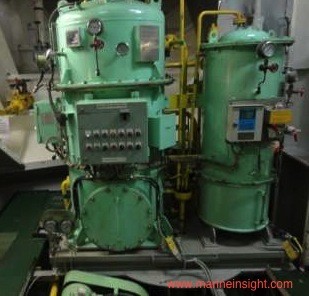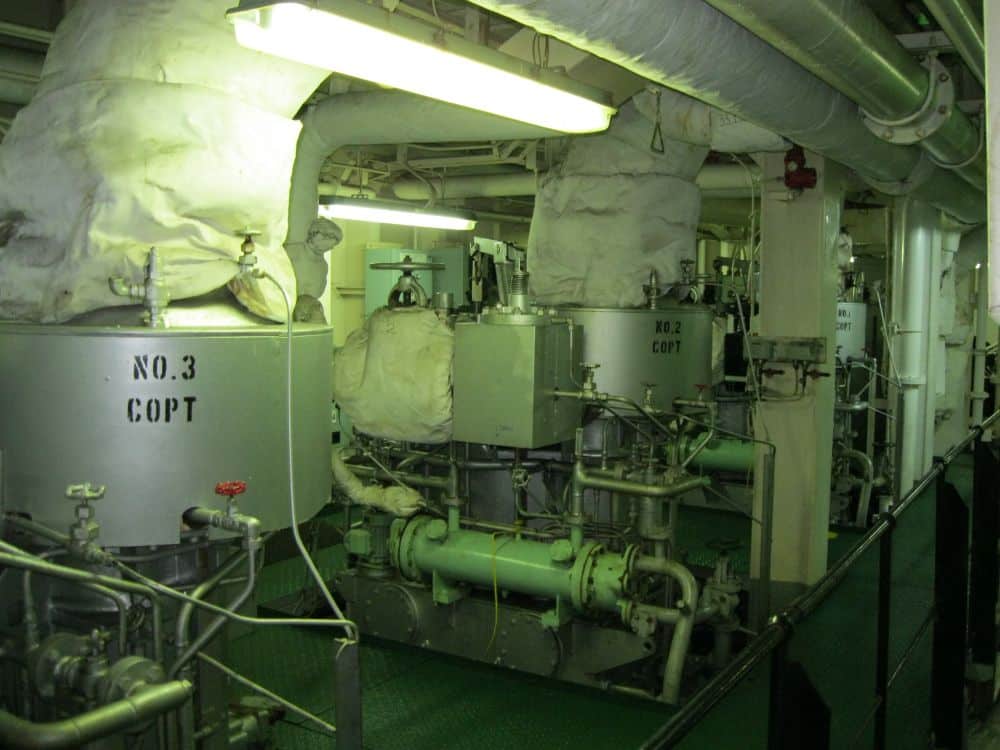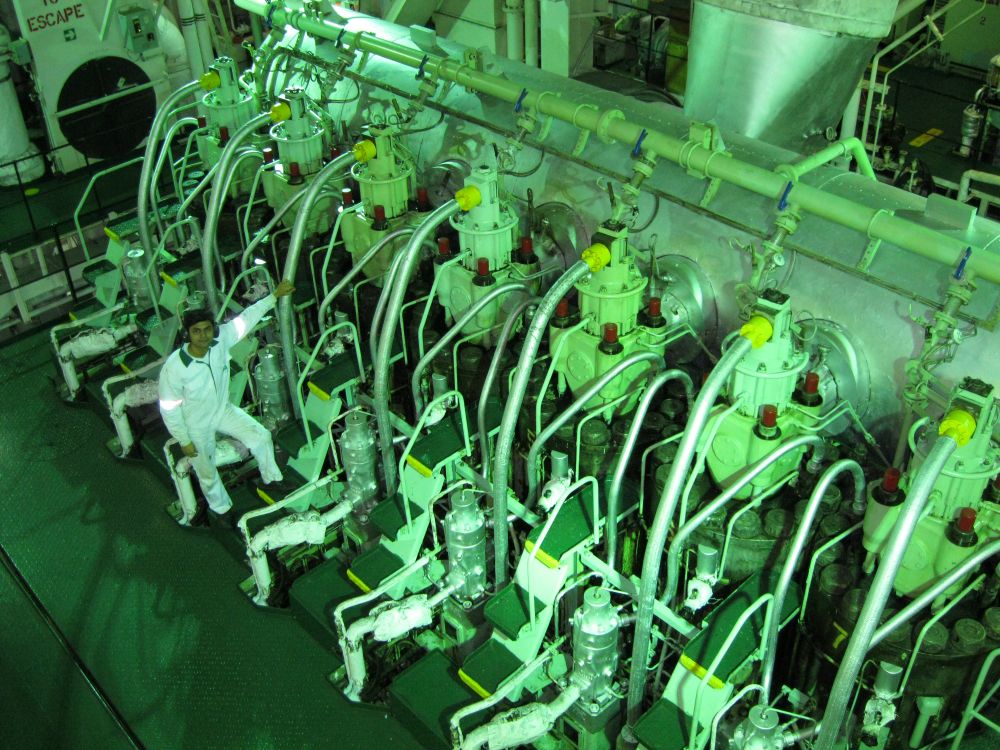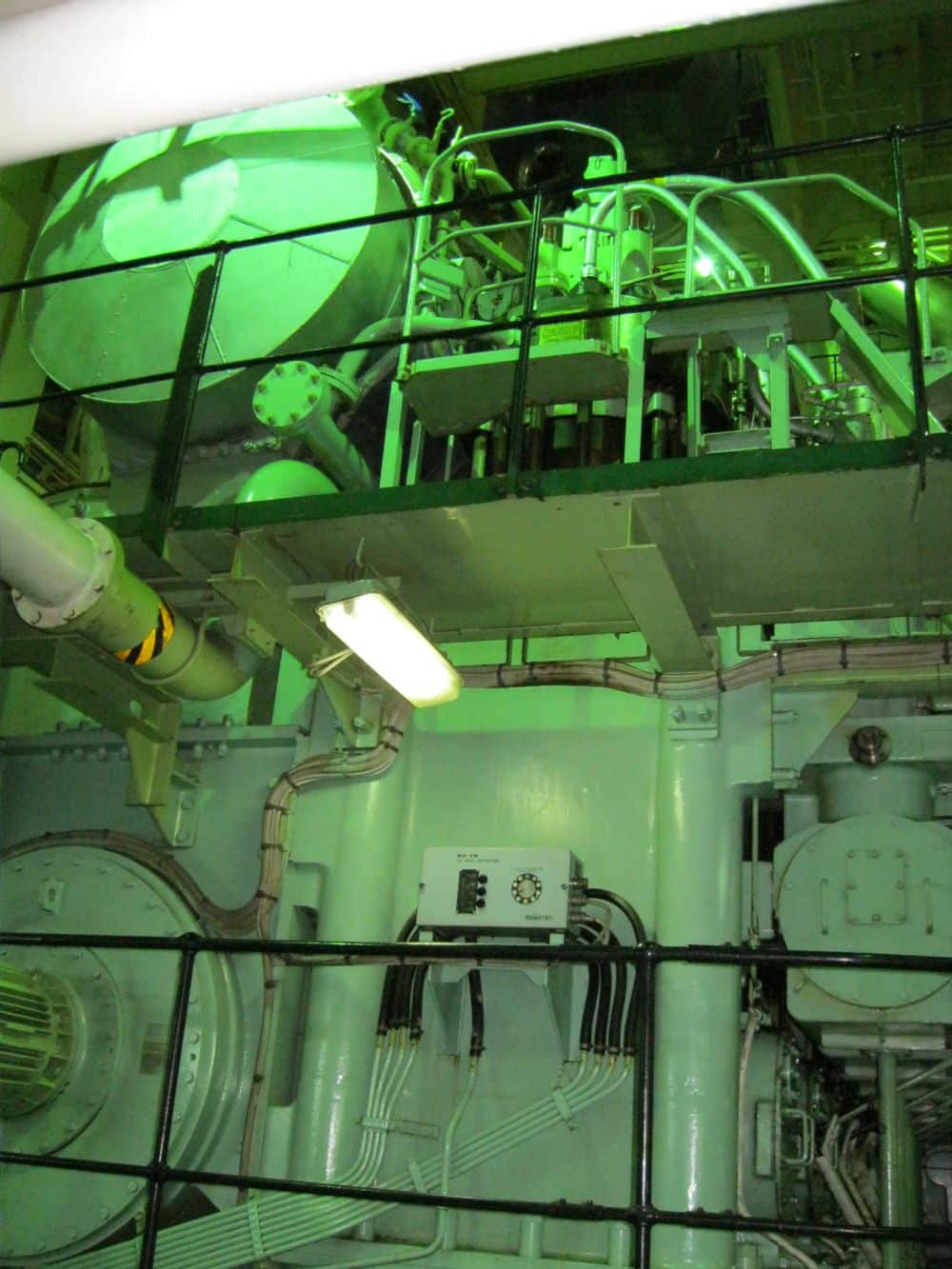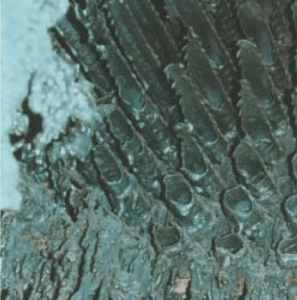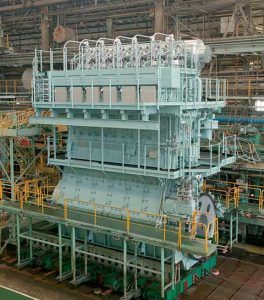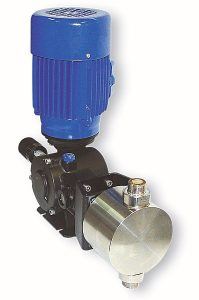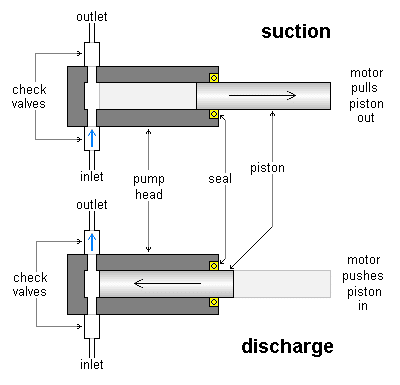Metering pump, as the name suggests, is a type of pump which is used on ship to pump a precise volume of liquid. Metering pump can be adjusted to provide different flow rates. They are generally used when the precision of volume to be delivered is very important.
The marine application of metering pump is in the form of chemical dosing pumps, which is used to transfer precise amount of dosing chemicals, especially in boilers. They are also used for dosing chemical additives to protect corrosion in the cooling water system. It is to note that the amount of dosing has to be precise. Over dosing or under dosing may cause corrosion and other damages inside the boiler, which may end up in heavy repairs.
The metering pump is connected to the system in which the chemicals are injected with the help of valve in the pipeline. The pressure produced by this pump should be higher than the pressure in the pipeline, or else there will not be any dosing and the level of chemicals in the dosing tank will be the same.
The metering pumps consist of a small motor which moves the plunger, in and out of the barrel, to provide pressure in the system. The check valves are provided in the suction and discharge side of the pump. Since the pump is of the plunger type, metering pump is a positive displacement pump.
Points to Note
For a positive displacement pump, the relief valve has to be provided in the discharge line. The reason for this is that the liquid is incompressible and there is no space in the barrel to accommodate the pressed liquid. A high pressure is created if the discharge valve is closed or if there is any other restriction/blockage in the system. The high pressure might completely damage the pipes connected. For this reason a relief valve is connected in the discharge line and is set at a particular pressure. When the pressure rises, the relief valve opens and relieves the extra pressure, thus protecting the pipes.
Generally metering pumps are connected to the dosing pumps and the whole unit is known as the dosing unit. The relief valve is connected to the dosing pump, which releases the excess pressure back to the dosing tank.
Working of Metering Pump
As the plunger moves away from the suction valve, a vacuum is created inside the pump because of which makes liquid flow inside the pump. This closes the check valve closes and the plunger again starts moving towards the valves. The discharge valve then opens and supplies the liquid to the system.
The seal arrangement is provided at the end of the plunger i.e. towards the motor side so that no leak should take place.
The volume of the liquid supplied can be altered by altering the movement of the plunger inside the barrel. This is generally done by a small knob provided on the pump and which thus allows adjusting the percentage of liquid supplied.
When the knob is turned to increase or decrease the flow rate, it alters the movement of the plunger, which means that it moves less in the plunger rather than along the full length of the plunger. Because of this the liquid enters the chamber and changes the plunger position along with the flow rate.
Image Credit
As a worldwide marine service agent, Ijin Marine Limited provides ship voyage repair, lifesaving inspection, fire-fighting inspection, radio inspection, and underwater hull cleaning, in more than 3000 ports of 100 countries. Below is a list of world's seaports, arranged by oceans and seas. Ijin has attended many jobs in some of them as below. The lifesaving equipment includes life boat, life raft, which is annually inspected accordingly to class requirement. Fire fighting equipment includes fire extinguisher (dry powder, CO2, foam, etc, hand type or wheeled type), firemen outfitting and cylinder, air breathing apparatus, EEBD, etc. Communication inspection includes GMDSS, AIS, SSAS, EPIRB, SVDR, VHF radio, etc. Underwater service includes inspection, hull cleaning, repairing, plugging, etc.
The list of jobs Ijin attending in the past.
M/V Changhang Xianghai, Turbarao, Brazil, Ship Store Supply
M/V Changhang Bohai, Kandle, India, Motor Rewinding
M/V Changhang An Hai, Amsterdam, Netherlands Or Holland, Store Supply
M/V CF Diamond, Vancouver, Canada, Oil Tank Repair For Life Boat
M/V CF Crystol, Vancouver, Canada, Hatch Cover Repair
M/V LR Lily, Kalimantan, Indonesia, Bearing Replacement For Crane
M/V Sky Jupiter, Johor Bahru, Malaysia, Provision And Ship Store Supply
M/V Sky Oceanus, Johor Bahru, Malaysia, Provision And Ship Store Supply
M/V Msc Sentosa, Johor Bahru, Malaysia, Provision And Ship Store Supply
M/V Man Hai, Jarkata, Indonesia, Life Raft Supply
M/V Jian Hua, Point Comfert, America, Ship Store Supply
M/V Long Hua, Dong Hae, Korea, Spare Part Delivery
M/V Xin Xiang An, Karaikal, India, Ship Store Supply
M/V Xin Bo Lin 3, Mumbai, India, Ship Store Supply
M/V Hui Tong 56, Belawan, Indonesia, Boiler Repair
M/V Zhe Hai 505, Aukland, New Zealand, Fire Fighting Equipment Inspection
M/V Zhe Hai 505, Vitoria, Brazil, Life Raft Inspection
M/V Zhe Hai 505, Rotterdam, Netherlands, Ship Store Supply
M/V Zhe Hai 505, San Lorenzo, Argentina, Ship Store Supply
M/V Da Xin Hua Li Shun, Ulsan, Korea, Fire Fighting, Life Saving And Gmdss Inspection
M/V Ratna Shalini, Gdansk, Poland, Gas Detector Calibration
M/V Cleantec, Casablanca, Morroco, Ship Store Supply
M/V Chang Hang An Hai, Taichuang, Taiwan, Auxiliary Engine Repair
M/V Chang Hang An Hai, Richard Bay, Australia, Ship Store Supply
M/V Rich Sino, Junk Bay Anchorage Of Hong Kong, Underwater Hulls Inspection, Pre Purchase.
Atlantic Ocean
List of ports and harbours of the Atlantic Ocean
Abidjan, Ivory Coast
Accra, Ghana
A Coruña, Spain
Port of Albany-Rensselaer, New York, United States
Bahía Blanca, Argentina
Coronel Rosales Partido, Argentina
General Belgrano, Buenos Aires, Argentina
Banana, Democratic Republic of the Congo
Barranquilla, Colombia
Belém, Brazil
Bergen, Norway
Bodø, Norway
Port of Boston, Massachusetts, United States
Botwood, Newfoundland and Labrador, Canada
Bridgetown, Barbados
Brunswick, Georgia, United States
Buenos Aires, Argentina
Calabar, Nigeria
Cabinda, Angola
Cádiz, Spain
Port Canaveral, Florida, United States
Cape May, New Jersey, United States
Cape Town, South Africa
Port of Casablanca, Morocco
Cayenne, French Guiana, France
Charleston, South Carolina, United States
Colón, Panama
Cork, Ireland
Dakar, Senegal
Douala, Cameroon
Elizabeth, New Jersey, United States
Ferrol, Spain
Freeport, Bahamas
Freetown, Sierra Leone
Fortaleza, Brazil
Galway, Ireland
Georgetown, Guyana
Port of Hafnarfjörður, Iceland
Port of Halifax, Nova Scotia, Canada
Hamilton, Bermuda
Hampton Roads, Virginia, United States
Harstad, Norway
Huelva, Spain
Jacksonville, Florida, United States
Lagos, Nigeria
Las Palmas de Gran Canaria, Canary Islands, Spain
Libreville, Gabon
Lisbon, Portugal
Lomé, Togo
Luanda, Angola
Malabo, Equatorial Guinea
Melford, Nova Scotia, Canada (proposed)
Port of Miami, Florida, United States
Monrovia, Liberia
Montevideo, Uruguay
Nantes, France
Narvik, Norway
Nassau, Bahamas
Port Newark, United States
Port of New York and New Jersey, United States
Paramaribo, Suriname
Pecém, Brazil
Port of Philadelphia, Pennsylvania, United States
Port Everglades, Florida, United States
Port Harcourt, Nigeria
Portland, Maine, United States
Porto, Portugal
Porto Alegre, Brazil
Quequén, Argentina
Recife, Brazil
Reykjavík, Iceland
Rio de Janeiro, Brazil
Salvador, Brazil
San Juan, Puerto Rico, United States
Santa Cruz de Tenerife, Canary Islands, Spain
Port of Santos near São Paulo, Brazil
Port of Savannah, Georgia, United States
St. Augustine, Florida, United States
Saint John, New Brunswick, Canada
Sept-Îles, Quebec, Canada
Setúbal, Portugal
Sines, Portugal
Stornoway, Scotland, United Kingdom
Shannon/Foynes, Ireland
St. John's, Newfoundland and Labrador, Canada
Tangier, Morocco
Tromsø, Norway
Trondheim, Norway
Port of Vigo, Spain
Vitória, Brazil
Walvis Bay, Namibia
Wilmington, Delaware, United States
Wilmington, North Carolina, United States
Ålesund, Norway
Paranaguá, Brazil
São Francisco do Sul, Brazil
Itajaí, Brazil
Porto Velho, Brazil
Santos, Brazil
Itapoá, Brazil
Adriatic Sea
Ancona, Italy
Port of Bar, Montenegro
Bari, Italy
Budva, Montenegro
Port of Durrës, Albania
Port of Koper, Slovenia
Port of Pescara, Italy
Port of Ploče, Croatia
Port of Rijeka, Croatia
Shën Gjin, Albania
Port of Split, Croatia
Port of Trieste, Italy
Venice, Italy
Port of Vlorë, Albania
Ravenna, Italy
Monfalcone, Italy
Chioggia, Italy
Porto Marghera, Italy
Aegean Sea
Alexandroupolis, Greece
Bodrum, Turkey
Chalcis, Greece
Chios, Greece
Eleusina, Greece
Heraklion, Crete, Greece
İzmir, Turkey
Kavala, Greece
Kuşadası, Turkey
Laurium, Greece
Mytilene, Greece
Piraeus, Greece
Rhodes, Greece
Thessaloniki, Greece
Volos, Greece
Azov Sea
Azov, Russia
Berdiansk, Ukraine
Mariupol, Ukraine
Taganrog, Russia
Yeysk, Russia
Baltic Sea
List of Ports of the Baltic Sea.
Bay of Biscay
Avilés, Spain
Bayonne, France
Burela, Spain
Port of Bilbao, Spain
Bordeaux, France
Brest, France
El Musel, Gijón, Spain
Pasaia, Spain
La Rochelle, France
Les Sables-d'Olonne, France
Santander, Spain
Black Sea
Batumi, Georgia
Bilhorod, Ukraine
Burgas, Bulgaria
Illichivsk, Ukraine
Mangalia, Romania
Midia, Năvodari, Romania
Novorossiysk, Russia
Odessa, Ukraine
Poti, Georgia
Port of Constanţa, Romania
Giurgiulesti International Free Port, Moldova
Port of Erdemir, Turkey
Port of Varna, Bulgaria
Samsun, Turkey
Sevastopol, Ukraine
Sukhumi, Georgia
Trabzon, Turkey
Yuzhny, Ukraine
Caribbean Sea
Basse-Terre, Guadeloupe, France
Belize City, Belize
Bridgetown, Barbados
Port of Cabo Rojo, Dominican Republic
Cartagena, Colombia
Chetumal, Mexico
Colón, Panama
Fort-de-France, Martinique, France
La Guaira, Venezuela
Guanta, Venezuela
Guantánamo, Cuba
Kingston, Jamaica
Limón, Costa Rica
Maracaibo, Venezuela
Oranjestad, Aruba, Netherlands
Pointe-à-Pitre, Guadeloupe, France
Ponce, Puerto Rico, United States
Port-au-Prince, Haiti
Port Caucedo, Dominican Republic
Port Rio Haina, Dominican Republic
Port of Spain, Trinidad and Tobago
Puerto Barrios, Guatemala
Puerto Cabello, Venezuela
Puerto Plata, Dominican Republic
Puerto Castilla, Honduras
Puerto Cortés, Honduras
Roatán, Honduras
Santiago de Cuba, Cuba
Port of Santo Domingo, Dominican Republic
Santo Tomás de Castilla, Guatemala
Willemstad, Curaçao, Netherlands
Chesapeake Bay
Baltimore, United States
Norfolk, Virginia, United States
Salisbury, Maryland, United States
English Channel
Caen (Ouistreham), France
Calais, France
Cherbourg, France
Dieppe, France
Port of Dover, United Kingdom
Le Havre, France
Port of London, United Kingdom
Dunkerque(Duinkerken), France
Newhaven, United Kingdom
Ostend, Belgium
St. Peter Port, Guernsey, United Kingdom
Portland Harbour, United Kingdom
Portsmouth, United Kingdom
Plymouth, United Kingdom
Ramsgate, United Kingdom
Saint-Malo, France
Shoreham-by-Sea, United Kingdom
Port of Southampton, United Kingdom
Great Lakes
Port of Montreal, Canada
Buffalo, New York, United States
Burns Harbor / Portage, Indiana, United States
Port of Chicago, Illinois, United States
Cleveland, Ohio, United States
Detroit, Michigan, United States
Duluth, Minnesota, United States
Erie, Pennsylvania, United States
Hamilton, Ontario, Canada
Kingston, Ontario, Canada
Milwaukee, Wisconsin, United States
Port of Montreal, Canada
Nanticoke, Ontario, Canada
Oshawa, Ontario, Canada
Port of Oswego Authority, New York, United States
Thunder Bay, Ontario, Canada
Two Harbors, Minnesota, United States
Toledo, Ohio, United States
Toronto, Ontario, Canada
Sault Ste. Marie, Ontario, Canada
Sault Ste. Marie, Michigan, United States
Irish Sea
Barrow-in-Furness, England
Belfast, Northern Ireland
Cairnryan, Scotland
Cardiff, Wales
Douglas, Isle of Man
Drogheda, Ireland
Dublin, Ireland
Dún Laoghaire, Ireland
Dundalk, Ireland
Ellesmere, England
Fishguard, Wales
Fleetwood, England
Garston, England
Glasgow, Scotland
Heysham, England
Holyhead, Wales
Larne, Northern Ireland
Liverpool, England
Milford Haven, Wales
Mostyn, Wales
Pembroke Dock, Wales
Rosslare Europort, Ireland
Runcorn, England
Stranraer, Scotland
Swansea, Wales
Sea of Marmara
Istanbul, Turkey
İzmit, Turkey
Tekirdağ, Turkey
Mediterranean Sea
Adana, Turkey
Alexandria, Egypt
Algeciras, Spain
Al Hoceima, Morocco
Algiers, Algeria
Almería, Spain
Antalya, Turkey
Port of Ashdod, Israel
Barcelona, Spain
Bardia, Libya
Beirut, Lebanon
Benghazi, Libya
Cagliari, Sardinia, Italy
Cartagena, Spain
Ceuta, Spain
Chalcis, Greece
Civitavecchia, Italy
Corinth, Greece
Datca, Turkey
Fethiye, Turkey
Genoa, Italy
Gibraltar (British Overseas Territory)
Gioia Tauro, Italy
Grand Harbour, Malta
Iskenderun, Turkey
Port of Haifa, Israel
Larnaca, Cyprus
Latakia, Syria
Leghorn, Italy
Limassol, Cyprus
Málaga, Spain
Marmaris, Turkey
Marseille, France
Melilla, Spain
Mersa Matruh, Egypt
Mersin, Turkey
Messina, Sicily, Italy
Misrata, Libya
Nador, Morocco
Naples, Italy
Oran, Algeria
Palma de Mallorca, Spain
Palermo, Sicily, Italy
Patras, Greece
Piraeus, Greece
Port Said, Egypt
Sidon, Lebanon
Tangier, Morocco
Tarragona, Spain
Tel Aviv, Israel
Thessaloniki, Greece
Tétouan, Morocco
Tripoli, Lebanon
Tripoli, Libya
Tunis, Tunisia
Valencia, Spain
Gulf of Mexico
Port of Beaumont, Texas, United States
Campeche, Mexico
Ciudad del Carmen, Mexico
Coatzacoalcos, Veracruz, Mexico
Port Corpus Christi, Texas, United States
Galveston, Texas, United States
Gulfport, Mississippi, United States
Havana, Cuba
Port of Houston, Texas, United States
Intracoastal City, Louisiana, United States
Lake Charles, Louisiana, United States
Louisiana Offshore Oil Port, Louisiana, United States
Matamoros, Tamaulipas, Mexico
Matanzas, Matanzas, Cuba
Port of Mobile, Alabama, United States
Port of New Orleans, Louisiana, United States
Panama City, Florida, United States
Pensacola, Florida, United States
Plaquemines Port, Louisiana, United States
Port Fourchon, Louisiana, United States
Progreso, Mexico
Port of Tampa, United States
Tampico, Tamaulipas, Mexico
Veracruz, Veracruz, Mexico
North Sea
List of North Sea ports
Aberdeen, Scotland, United Kingdom
Port of Amsterdam, Netherlands
Port of Antwerp, Belgium
Blyth, England, United Kingdom
Bremerhaven, Germany
Bremen, Germany
Port of Bruges-Zeebrugge, Belgium
Cuxhaven, Germany
Delfzijl, Netherlands
Dundee, Scotland, United Kingdom
Eemshaven, Netherlands
Emden, Germany
Esbjerg, Denmark
Port of Felixstowe, United Kingdom
Flotta, Scotland, United Kingdom
Port of Ghent, Belgium
Gothenburg, Sweden
Grimsby, United Kingdom
Port of Hamburg, Germany
Harwich International Port, England, United Kingdom
Immingham, England, United Kingdom
Hull, England, United Kingdom
Kristiansand, Norway
Leith, Scotland, United Kingdom
Port of London, England, United Kingdom
Middlesbrough, England, United Kingdom
Newcastle, England, United Kingdom
Oostende, Belgium
Oslo, Norway
Port of Rotterdam, Netherlands & Europoort
Stavanger, Norway
Terneuzen, Netherlands
Sullom Voe, Scotland, United Kingdom
Sunderland, England, United Kingdom
Thamesport, Isle of Grain, England, United Kingdom
Port of Tilbury, England, United Kingdom
Vlissingen, Netherlands
Wilhelmshaven, Germany & JadeWeserPort
Ålesund, Norway
Øresund
Copenhagen, Denmark
Helsingborg, Sweden
Malmö, Sweden
Ottawa River/Saint Lawrence River
Montreal, Quebec, Canada
Quebec City, Quebec, Canada
Trois-Rivières, Quebec, Canada
Bécancour, Quebec, Canada
Gulf of Paria
Pedernales, Venezuela
Point Lisas, Trinidad and Tobago
Port of Spain, Trinidad and Tobago
Scarborough, Trinidad and Tobago - since 1991
Tyrrhenian Sea
Civitavecchia, Italy
Naples, Italy
Livorno, Italy
Arctic Ocean
List of ports and harbours of the Arctic Ocean
Akureyri, Iceland
Arkhangelsk, Russia
Barrow, Alaska, United States
Belomorsk, Russia
Churchill, Manitoba, Canada
Dikson, Russia
Dudinka, Russia
Hammerfest, Norway
Honningsvåg, Norway
Kandalaksha, Russia
Igarka, Russia
Kirkenes, Norway
Murmansk, Russia
Naryan-Mar, Russia
Severomorsk, Russia
Tiksi, Russia
Pevek, Russia
Prudhoe Bay, Alaska, United States
Vardø, Norway
Vitino, Russia
Indian Ocean
List of ports and harbours of the Indian Ocean
Adelaide, South Australia, Australia
Jawaharlal Nehru Port Trust, Navi Mumbai, Maharashtra, India
Cochin, Kerala, India
Colombo, Sri Lanka
Port of Madras, Tamil Nadu, India
Durban, South Africa
Fremantle, Western Australia, Australia
Haldia, West Bengal, India
Jakarta, Indonesia
Kakinada, Andhra Pradesh, India
Krishnapatnam, Andhra Pradesh, India
Kandla, Gujarat, India
Port of Karachi, Sindh, Pakistan
Mundra, Gujarat, India
Mangalore, Karnataka, India
Machilipatnam, Andhra Pradesh, India
Maputo, Mozambique
Mogadishu, Somalia
Port of Mumbai, Maharashtra, India
Paradeep, Odisha, India
Portland, Victoria, Australia
Port Hedland, Western Australia, Australia
Port Elizabeth, South Africa
Port Lincoln, South Australia, Australia
Port Louis, Mauritius
Port Pirie, South Australia, Australia
Port Blair, Andaman & Nicobar Islands, India
Richards Bay, South Africa
Mombasa, Kenya
Visakhapatnam, Andhra Pradesh, India
Port of Kolkata, West Bengal, India
Tuticorin, Tamil Nadu, India
Gulf of Aden
Aden, Yemen
Berbera, Somalia
Mukalla, Yemen
Port of Djibouti, Djibouti
Arabian Sea
Gwadar Port, Gwadar, Balochistan, Pakistan
Karachi Port, Karachi, Sindh, Pakistan
Keti Bandar, Sindh, Pakistan
Port Qasim, Sindh, Pakistan
Port of Ormara, Ormara, Balochistan, Pakistan
Port of Pasni, Pasni, Balochistan, Pakistan
Mundra Port, Gujarat, India
New Mangalore port, Karnataka, India
INS Kadamba, Karnataka, India
Cochin Port, Kerala, India
Kandla Port, Gujarat, India
Mormugão, Goa, India
Jawaharlal Nehru Port Trust, Navi Mumbai, Maharashtra, India
Al Duqm Port & Drydock, Duqm, Al Wusta Region, Oman
Port of Salalah, Salalah, Dhofar Governorate, Oman
Port of Bushehr, Bushehr Province, Iran
Bandar-Abbas, Hormozgan, Iran
Bay of Bengal
Chennai, Tamil Nadu, India
Cuddalore, Tamil Nadu, India
Chittagong Port, Chittagong Bangladesh
Ennore, Tamil Nadu, India
Kakinada, Andhra Pradesh, India
Machilipatnam, Andhra Pradesh, India
Mongla Port, Khulna, Bangladesh
Nagapattinam, Tamil Nadu, India
Paradeep, Odisha, India
Tuticorin, Tamil Nadu, India
Visakhapatnam, Andhra Pradesh, India
Gangavaram Port, Visakhapatnam, Andhra Pradesh, India
Dhamra, Odisha, India
Gopalpur, Odisha, India
Hooghly River
Haldia, West Bengal, India
Port of Kolkata, West Bengal, India
Strait of Malacca
Johor Port, Malaysia
Port Klang, Malaysia
Northport
West Port
Southpoint
Penang, Malaysia
Port of Singapore, Singapore
Tanjung Langsat Port, Johor, Malaysia
Port of Tanjung Pelepas, Malaysia
Gulf of Martaban
Yangon, Myanmar
Sea of Oman
Port of Chabahar, Iran
Port Sultan Qaboos, Muttrah, Muscat Governorate, Oman
Port of Sohar, Sohar, Dhofar Governorate, Oman
Khawr Fakkan, Sharjah, UAE
Gwadar Port, Balochistan, Pakistan
Chingari Port, Sindh, Pakistan
Persian Gulf
Bandar Abbas, Iran
Bandar Imam Khomeini, Iran
Dammam, Saudi Arabia
Doha, Qatar
Dubai, UAE
Hamriyah Port, Sharjah, UAE
Khafji, Saudi Arabia
Khobar, Saudi Arabia
Shuwaikh port, Kuwait
Jebel Ali, Dubai, UAE
Jubail, Saudi Arabia
Khalifa Bin Salman Port, Hidd, Bahrain
Mina Salman Port, Manama, Bahrain
Ras Tanura, Saudi Arabia
Port Phillip
Geelong, Victoria, Australia
Port of Melbourne, Australia
Red Sea
Aqaba, Jordan
Ain Sokhna, Egypt
Asseb, Eritrea
Djibouti City, Djibouti
Dubai, Saudi Arabia
Port of Eilat, Israel
Farasan (city), Saudi Arabia
Hurghada, Egypt
Jeddah, Saudi Arabia
Jizan, Saudi Arabia
Massawa, Eritrea
Port Sudan, Sudan
Rabigh, Saudi Arabia
Suez, Egypt
Yanbu, Saudi Arabia
Pacific Ocean
List of ports and harbours of the Pacific Ocean
Acapulco, Mexico
Auckland, New Zealand
Aurora, Philippines
Buenaventura, Colombia
Cabo San Lucas, Mexico
Cagayan Freeport, Philippines
Caldera, Puntarenas, Costa Rica
Callao, Peru
Corinto, Nicaragua
Port of Davao, Philippines
Port of Ensenada, Mexico
Eureka, California, United States on Humboldt Bay
Fraser Port, British Columbia, Canada
Guayaquil, Ecuador
Port of Hong Kong, People's Republic of China
Honolulu, Hawaii, United States
Iquique, Chile
Port of Kobe, Japan
Legazpi, Philippines
Port of Long Beach, California, United States
Port of Los Angeles, California, United States
Lyttelton, New Zealand
Napier, New Zealand See also: Port of Napier
Mazatlán, Mexico
Panama City, Panama
Port Chalmers, New Zealand
Port Hueneme, California, United States
Puerto Montt, Chile
Port of Napier, New Zealand
Port of Prince Rupert, British Columbia, Canada
Puerto Vallarta, Mexico
San Antonio, Chile
Port of San Diego, California, United States
Surigao, Philippines
Tabaco, Philippines
Tauranga, New Zealand
Timaru, New Zealand
Valparaíso, Chile
Viña del Mar, Chile
Wellington, New Zealand
Port of Yokohama, Japan
Sai Gon New Port, Ho Chi Minh City, Viet Nam
Columbia River
Port of Longview, Washington, United States
Port of Portland, Oregon, United States
Drake Passage, Beagle Channel and Strait of Magellan
Puerto Williams, Chile
Punta Arenas, Chile
Ushuaia, Argentina
Sacramento–San Joaquin rivers
Sacramento, California, United States
Gulf of Alaska
Port of Anchorage, Alaska, United States
Juneau, Alaska, United States
Arafura Sea
Darwin, Northern Territory, Australia
Bering Strait
Nome, Alaska, United States
Bohai Sea
Tianjin, People's Republic of China
Dongying, People's Republic of China
Qinhuangdao, People's Republic of China
Jinzhou, People's Republic of China
Yingkou, People's Republic of China
Hangu, People's Republic of China
Gulf of Carpentaria
Weipa, Queensland, Australia
Coral Sea
Bundaberg, Queensland, Australia
Port of Brisbane, Queensland, Australia
Gladstone, Queensland, Australia
Hay Point, Queensland, Australia
Port Moresby, Papua New Guinea
Townsville, Queensland, Australia
East China Sea
Ningbo, People's Republic of China
Kaohsiung, Taiwan
Keelung, Taiwan
Gulf of Thailand
Bangkok, Thailand
Laem Chabang, Thailand
Sihanoukville Autonomous Port, Kingdom of Cambodia
Korea Bay
Dalian, People's Republic of China
Lushun/Lushunkou, People's Republic of China
Namp'o, North Korea
Sinǔiju, North Korea
Yangtze River / Changjiang
Chongqing, People's Republic of China
Port of Shanghai, People's Republic of China
Wuhan, People's Republic of China
Gulf of California
Port of Pichilingue/La Paz, Mexico (UNESCO Whale Sactuary and Bio-Reserve)
Sea of Japan
Port of Busan, South Korea
Rason, North Korea
Hungnam, North Korea
Gangneung, South Korea
Nakhodka, Russia
Vladivostok, Russia
Vostochny, Russia
Wonsan, North Korea
Puget Sound/Strait of Georgia
Port of Vancouver, Canada
Port of Bellingham, Washington, United States
Port of Everett, Washington, United States
Port of Seattle, Washington, United States
Surrey, British Columbia, Canada
Port of Tacoma, Washington, United States
Port of Vancouver, British Columbia, Canada
Victoria, British Columbia, Canada
San Francisco Bay
Port of Oakland, California, United States
Port of Redwood City, Redwood City, California, United States
Richmond, California, United States
San Francisco, California, United States
Vallejo, California, United States
Stockton, California, United States
Pittsburg, California, United States
South China Sea
Batangas, Philippines
Cam Ranh, Vietnam
Cebu, Philippines
Da Nang, Vietnam
Hai Phong, Vietnam
Iloilo, Philippines
Ka-Ho, Macau (People's Republic of China)
Kemaman Port, Terengganu, Malaysia
Ho Chi Minh City (Saigon port), Vietnam
Port of Kaohsiung, Republic of China (Taiwan)
Kota Kinabalu, Sabah, Malaysia
Kuantan Port, Pahang, Malaysia
Kuching Port, Sarawak, Malaysia
Miri Port, Sarawak, Malaysia
Rejang Port, Sarawak, Malaysia
Bintulu Port, Sarawak, Malaysia
Kwai Chung, Hong Kong, People's Republic of China
Port of Manila, Philippines
Muara Port, Brunei
Puerto Princesa, Philippines
Port of Shenzhen, Guangdong, People's Republic of China
Subic Bay, Philippines
Tuen Mun, Hong Kong People's Republic of China
Van Phong, Vietnam
Yantian, Shenzhen, Guangdong, People's Republic of China
Zamboanga, Philippini
Pearl River / Zhujiang
Port of Guangzhou, Guangdong, People's Republic of China
Tasman Sea
Botany Bay (Port Botany), New South Wales, Australia* Hobart, Tasmania, Australia
Nelson, New Zealand
Newcastle, New South Wales, Australia
New Plymouth, New Zealand
Port Jackson (Sydney Harbour), New South Wales, Australia
Port Kembla, New South Wales, Australia
Yellow Sea
Haenam, South Korea
Port of Incheon, South Korea
Qingdao, People's Republic of China
Rizhao, People's Republic of China
Tianjin, People's Republic of China
Weihai, People's Republic of China
